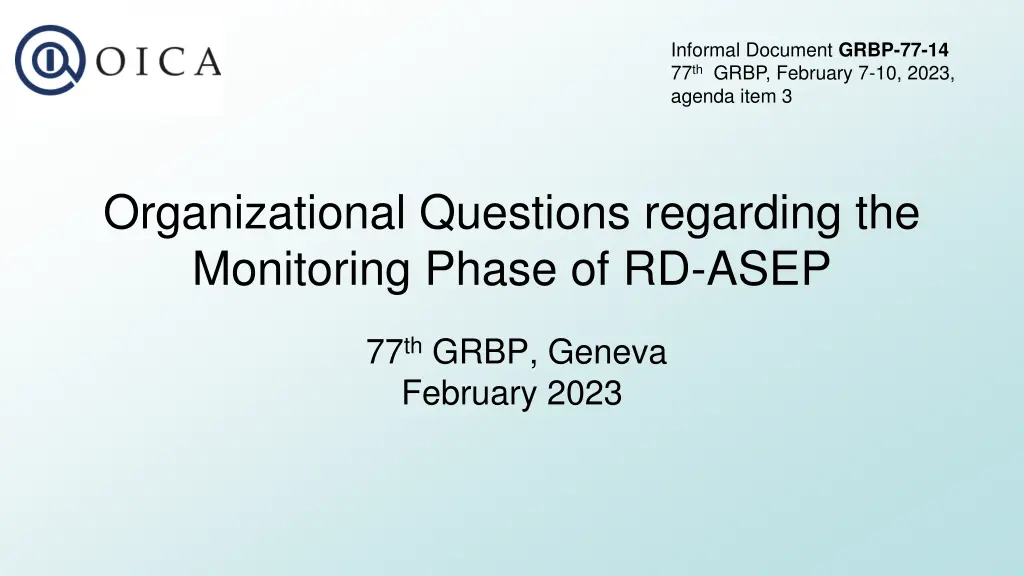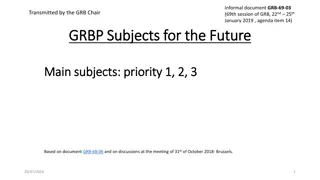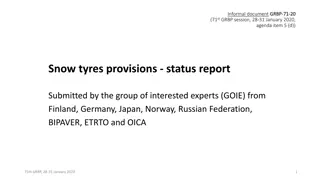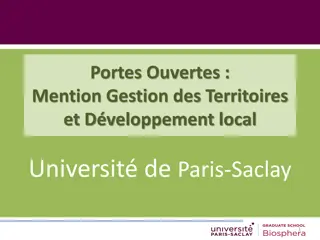
Monitoring Phase of RD-ASEP Agenda
Explore the organizational questions regarding the monitoring phase of RD-ASEP at the 77th GRBP session in February 2023. The agenda includes discussions on new real driving measuring methods and exemptions for vehicles under UN Regulation No. 51. Stay updated on the latest developments in vehicle sound emission provisions.
Download Presentation

Please find below an Image/Link to download the presentation.
The content on the website is provided AS IS for your information and personal use only. It may not be sold, licensed, or shared on other websites without obtaining consent from the author. If you encounter any issues during the download, it is possible that the publisher has removed the file from their server.
You are allowed to download the files provided on this website for personal or commercial use, subject to the condition that they are used lawfully. All files are the property of their respective owners.
The content on the website is provided AS IS for your information and personal use only. It may not be sold, licensed, or shared on other websites without obtaining consent from the author.
E N D
Presentation Transcript
Informal Document GRBP-77-14 77thGRBP, February 7-10, 2023, agenda item 3 Organizational Questions regarding the Monitoring Phase of RD-ASEP 77thGRBP, Geneva February 2023
Background & Situation 75thGRBP: ECE/TRANS/WP.29/GRBP/2022/4 (IWG ASEP) Proposal for Supplement 9* to 03 series of amendments to UN Regulation No. 51 * included in the consolidated Supplement 7 to 03 series of amendments to UN Regulation No. 51 ECE/TRANS/WP.29/2022/84 New Real Driving Measuring-Method for Additional Sound Emission Provisions (RD-ASEP). GRBP-75-37 (IWG ASEP) Amendment to Working Document GRBP/2022/4 proposed by the experts of the 17th session One year monitoring phase for the new method RD-ASEP from July 2023 to June 2024 required! 76thGRBP: ? GRBP-76-10 (OICA) Questions to GRBP according to ECE/TRANS/WP.29/GRBP/2022/4 and GRBP-75-37 (Monitoring phase of RD-ASEP from 1 July 2023) ! ECE/TRANS/WP.29.GRBP/74 (Secretariat) & Reminder by Email Report of the Working Party on Noise and Tyres on its Seventy-Sixth Session (5 7 Sept. 2022) 7.The expert from OICA raised a number of practical questions on collecting and analysing test data for the Real Driving Additional Sound Emission Provisions (RD ASEP) (GRBP-76-10). GRBP invited contracting parties applying UN Regulation No. 51 to prepare proposals on this issue and agreed to revert to it at the next session.
Vehicles in Scope of RD-ASEP according to Regulation No. 51 Supplement 7 UN Reg. No. 51.03, Supplement 7, Annex 9 Measurement Method RD-ASEP, Paragraph 1.: The Real Driving Additional Sound Emission Provisions (RD-ASEP) apply only to vehicles of categories M1 and N1 equipped with: an internal combustion engine (ICE) for propulsion of the vehicle, or any other propulsion technology fitted with an exterior sound enhancement system. 1.2 Exemptions Notwithstanding the requirements above, vehicles which have no ICE for propulsion are exempted from RD- ASEP, if a sound enhancement system is fitted to the vehicle solely for the purpose of fulfilling the provisions of UN Regulation No. 138, and the sound emitting device (AVAS) does not emit a sound pressure level of more than 75 dB(A) under any operation conditions exceeding the specification range of UN Regulation No.138. UN Reg. No. 51.03, Paragraph 5 Approval, Sub-Paragraph 5.1.1.: For vehicles with PMR not exceeding 60, the performance of RD-ASEP tests is not mandatory. UN Reg. No. 51.03, Supplement 7, Annex 7 Measurement Method ASEP, Paragraph 1.: This annex describes a measurement method to evaluate compliance of the vehicle with the additional sound emission provisions (ASEP) conforming to paragraph 6.2.3. of this Regulation. RD ASEP to be tailored to vehicles with additional sound emission provisions (ASEP) after monitoring phase!
Communication of RD-ASEP Results according to Regulation No. 51 Supplement 7 UN Reg. No. 51.03, Supplement 7, Annex 9 Measurement Method RD-ASEP, Appendix 5: UN Reg. No. 51.03, Paragraph 5 Approval, Sub-Paragraph 5.1.1.: The test results shall be communicated to the Type Approval Authority in the format according to the test report sheet of Appendix 5 in Annex 9. For the purpose of type approval, it is not mandatory to comply with the provisions of Annex 9. For vehicles with PMR not exceeding 60, the performance of RD-ASEP tests is not mandatory. RD-ASEP tests are not applicable to any tests done for the purpose of extension of existing approvals according to UN Regulation No. 51. In case the type approval tests of Annex 3 and Annex 7 were carried out in an indoor facility, the test and the delivery of data according to Annex 9 are not mandatory. The requirements for a Type Approval Report with RD ASEP are described in Appendix 5 of Annex 9. During monitoring phase an expanded format is needed to enable a data analysis.
Questions of GRBP-76-10 on Collecting and Analyzing Test Data Who is responsible for monitoring data gathered during a type-approval process? Who shall send the data? How often shall it be sent ( continuously or by packet )? Are the data already anonymous when sent to OICA? Who will check the quality of the submitted data? Data Analysis? Who is willing to join this research program? As a first step ACEA has already prepared an automated data entry sheet for RD- ASEP (in regard to Appendix 5 of Annex 9)
Data Entry Sheet Overview prepared by ACEA Sheet - Title Sheet Content Data entry Confidential How to use the data entry sheet? (0) Instructions Identification of data owner, confidential and will not be published at any time. Description of vehicle, needed for Sound Expectation Model (SEM), base for monitoring database Type approval data, published in monitoring database (0) Approval Information (1) Vehicle Data (2) Annex 3 Data Preparations to establish the Sound Exp. Model SEM (3) Annex 9 - Setup Data Optional tyre measurement results (3a) Annex 9 - Tyre Rolling Sound RD ASEP test results (4) Annex 9 Test Report Sheet Only for calculation (4a) Annex 9 - SUB Calculation Only for calculation (4b) Annex 9 Parameter Table Supplement to the monitoring (5) Questionaire
Data Entry Sheet RD-ASEP Result (4) Annex 9 - Test Report Sheet
Data Entry Sheet RD-ASEP Result (5) Questionaire 1. How easy was it getting involved with the RD-ASEP regulation text of UN R51.03 Annex 9? 2. Did you face any greater difficulties in understanding the RD-ASEP specifications? 3. Did you face any greater difficulties in picking the essential RD-ASEP base model parameter from the Annex 3 test? 4. How was your experience in performing the RD-ASEP physical tests with a vehicle? 5. Did you face difficulties to find valid test target conditions satisfying the control range specifications? 6. How was the experience of the driver to match the target conditions?? 7. Did you face difficulties with your test equipment to measure / determine the requested parameter? 8. Did you try to establish your own RD-ASEP assessment sheet, aside from the provided template here? 9. Were you able to reach an RD-ASEP evaluation for the vehicle to which you deliver this monitoring sheet? 10. How do you rate the necessary workload for RD-ASEP in comparison to the current ASEP (when tests are carried out)? Please send the complete Data Entry Sheet as an Excel-file to XXX@UTAC.COM (Outcome of GRBP-77-13 Corrigendum of UN-R51 RD-ASEP Monitoring.doc)
Questions of GRBP-76-10 on Collecting and Analyzing Test Data Who is responsible for monitoring data gathered during a type-approval process? Who shall send the data? How often shall it be sent ( continuously or by packet )? Are the data already anonymous when sent to OICA? Who will check the quality of the submitted data? Data Analysis? Who is willing to join this research program? Answers are needed now, since monitoring phase starts July 1st, 2023
RD ASEP Monitoring Phase OICA S PROPOSED ANSWERS
OICAs Proposed Answers to Questions of GRBP-76-10 Who is responsible for monitoring data gathered during a type-approval process? Type Approval Authorities are responsible. Type Approval Authorities shall require their technical services to collect the data (via given data entry sheet) during the Type Approval Process (mandatory). Who shall send the data? How often shall it be sent ( continuously or by packet )? Technical Services shall send it by packet every three months to an independent contractor. Data submitted after September 2024 can not be guaranteed to be processed by the contractor. Are the data already anonymous when sent to OICA? Who will check the quality of the submitted data? The datasets are not anonymous when send to the independent contractor. No manufacturer will have access to datasets of other manufacturers. The datasets will be anonymized by the contractor. In case of bad data quality, the independent contractor will contact the manufacturer/technical service to improve the quality data sets.
OICAs Proposed Answers to Questions of GRBP-76-10 Data Analysis? After the monitoring phase the independent contractor will achieve basic analysis. Study sponsors will present results to IWG ASEP & GRBP. Who is willing to join this research program? We recommend Contracting Parties (CPs, both 1958 and 1998 agreement) join the monitoring data analysis process to avoid any questions of bias. Industry should not be the only sponsor of this research program. We proposed a balanced budget share between CPs and industry. Statement of intent needed by end of February 2023. Industry has proactively chosen an independent contractor. This contractor is ready to cooperate with contracting parties representatives.
Benefits of a Joint Approach (CPs and Industry) Access to database with anonymized test data. Co-Determination of the scope of analysis work Joint release of work results & presentations to GRBP Lowest total cost approach Further investigations possible by any study sponsor Statement of intent needed by end of February 2023 to meet the regulatory timing.



